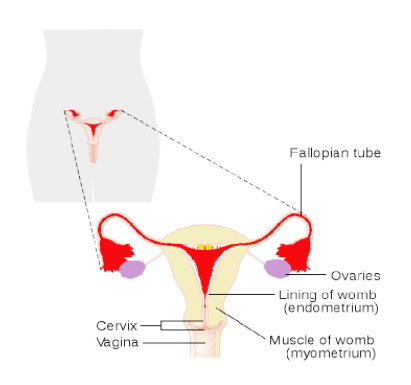Answer
395.4k+ views
Hint: Fertilization or fusion of sperm and egg occurs after the release of an ovum in the oviduct of the female reproductive tract. Following fertilization, the formed zygote gets implanted into one of the linings of the uterus which normally shed in menstrual flow in a non-pregnant woman.
Complete answer:

- The female reproductive tract or system consists of a pair of ovaries, a pair of oviducts (Fallopian tube), a uterus, a cervix, and a vagina.
- The ovary is the primary female sex organ where the egg or ova gets produced. Just after the ovary, the fallopian tube (oviduct) extends to the uterus which consists of three parts:
- The infundibulum is the funnel-shaped region present closer to the ovary. It bears finger-like projections called fimbriae to collect the ovum from the ovary.
- The ampulla is a wider part of the oviduct found just after the infundibulum towards the uterus.
- Isthmus is the narrowest part of the oviduct that ends at the uterus.
- The oviduct acts as a site of fertilization. More specifically, the ampullary-isthmic junction of the oviduct is the site of fertilization.
- The uterus is a hollow, muscular, inverted pear-shaped structure found in the pelvic region of the human female.
- The wall of the uterus is composed of three layers, outer perimetrium, middle muscular myometrium, and innermost highly vascular and glandular endometrium.
- The endometrium is the site of implantation because it has a blood supply and glands.
- So, the correct answer is that the site of fertilization is the ampullary-isthmic junction of the oviduct, and the endometrium of the uterus is the site for implantation of the zygote.
Note: One-celled zygote starts to divide through cleavage into millions of cells and at a stage, called the blastocyst, it implants into the endometrium of the uterus. The ampullary-isthmic junction is the site of fertilization and endometrium provides the site for implantation because it can provide oxygen and nutrients for the cleavage process until the embryo does not form the placenta.
Complete answer:

- The female reproductive tract or system consists of a pair of ovaries, a pair of oviducts (Fallopian tube), a uterus, a cervix, and a vagina.
- The ovary is the primary female sex organ where the egg or ova gets produced. Just after the ovary, the fallopian tube (oviduct) extends to the uterus which consists of three parts:
- The infundibulum is the funnel-shaped region present closer to the ovary. It bears finger-like projections called fimbriae to collect the ovum from the ovary.
- The ampulla is a wider part of the oviduct found just after the infundibulum towards the uterus.
- Isthmus is the narrowest part of the oviduct that ends at the uterus.
- The oviduct acts as a site of fertilization. More specifically, the ampullary-isthmic junction of the oviduct is the site of fertilization.
- The uterus is a hollow, muscular, inverted pear-shaped structure found in the pelvic region of the human female.
- The wall of the uterus is composed of three layers, outer perimetrium, middle muscular myometrium, and innermost highly vascular and glandular endometrium.
- The endometrium is the site of implantation because it has a blood supply and glands.
- So, the correct answer is that the site of fertilization is the ampullary-isthmic junction of the oviduct, and the endometrium of the uterus is the site for implantation of the zygote.
Note: One-celled zygote starts to divide through cleavage into millions of cells and at a stage, called the blastocyst, it implants into the endometrium of the uterus. The ampullary-isthmic junction is the site of fertilization and endometrium provides the site for implantation because it can provide oxygen and nutrients for the cleavage process until the embryo does not form the placenta.
Recently Updated Pages
Basicity of sulphurous acid and sulphuric acid are

What is the stopping potential when the metal with class 12 physics JEE_Main

The momentum of a photon is 2 times 10 16gm cmsec Its class 12 physics JEE_Main

Using the following information to help you answer class 12 chemistry CBSE

Which of the following would not be a valid reason class 11 biology CBSE

Why should electric field lines never cross each other class 12 physics CBSE

Trending doubts
Difference between Prokaryotic cell and Eukaryotic class 11 biology CBSE

Fill the blanks with the suitable prepositions 1 The class 9 english CBSE

Write an application to the principal requesting five class 10 english CBSE

Difference Between Plant Cell and Animal Cell

a Tabulate the differences in the characteristics of class 12 chemistry CBSE

Change the following sentences into negative and interrogative class 10 english CBSE

What organs are located on the left side of your body class 11 biology CBSE

Discuss what these phrases mean to you A a yellow wood class 9 english CBSE

List some examples of Rabi and Kharif crops class 8 biology CBSE



